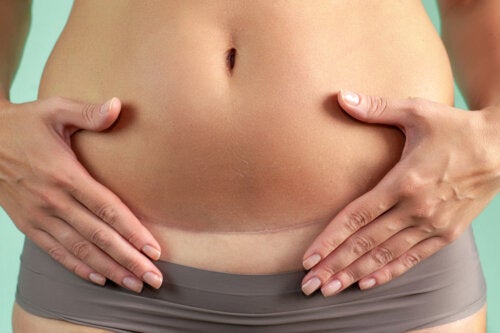How to Relieve Gas After a C-Section

Gas after a C-section is a common symptom in the postoperative period. Most mothers complain about it, as it increases the discomfort of surgery and postpartum. Therefore, today we’re going to tell you about some measures that can be implemented to avoid and relieve this ailment. If you’re interested, keep reading!
Is gas after a C-section normal?
It’s normal to experience abdominal gas after a cesarean section, as it’s produced spontaneously by the paralysis of the intestines and accumulates inside them. This phenomenon occurs inevitably due to the surgical procedure and epidural anesthesia.
The presence of gas in the intestines is manifested through cramping and abdominal pain (intermittent), whose intensity can be moderate to intense. Some women describe it as severe pins and needles or stabbing, located right in the area of surgery or elsewhere in the belly.
Occasionally, the pain can also appear in other areas of the body, such as the back, chest, collarbones, or shoulders. This is called referred pain and is related to the type of nerves that are stimulated within the abdominal cavity.

Is there any way to avoid gas after a C-section?
Because bowel immobilization is an expected event after epidural anesthesia, there’s little that can be done to avoid gas in the postoperative period. However, there are 2 important recommendations that help to limit them considerably:
- Do not talk after a cesarean section. When we talk, we swallow air involuntarily and this accumulates with the air that’s already retained in the intestine. As the hours go by, the digestive tract will move again and then, when you’re able to eliminate the gas, you can start talking.
- Walk as soon as possible. A cesarean section is a complex surgical procedure that may prevent mobilization and ambulation for a few hours. However, it’s important to try to change position in bed, stand up, and walk as soon as possible. This way, the bowels will begin to move and the expulsion of gases will be stimulated.
How long do postpartum gases last?
This is very variable and you should know that they generally subside a few days after giving birth. However, they may continue to bother you for a few weeks, but with much less intensity. Above all, you should consult your doctor if this discomfort is very frequent and intense in the postpartum period.
How to relieve gas after a cesarean section?
Although they’re not always preventable, fortunately, cesarean section gas can be relieved. Especially when you’re able to move around. Here are some useful tips to limit the discomfort. Take note!
Place warm compresses on your abdomen
It’s a good idea to place a warm compress on this area of pain to relieve it. However, be careful not to place it directly over the cesarean wound, as this could be counterproductive to healing.
Maintain a balanced diet
In the days following the cesarean section, it’s important to take care of your diet.
On the one hand, you should pay attention to the quality of your diet. The consumption of fruits and vegetables is very necessary for a good recovery, as well as avoiding fried and ultra-processed foods. In addition, it’s food to limit the intake of those foods that tend to cause gas, such as legumes, cauliflower, cabbage and dairy products.
On the other hand, you need to modify some habits around meals. It’s best to avoid abundant dishes and opt for eating several times a day, in smaller quantities, and chewing food very well. Also, you need to opt for grilled or steamed food, in order to make digestion lighter.
Don’t forget that it’s important to avoid drinking beverages with sherbet, chewing gum, and smoking.
Ensure good hydration
Staying hydrated helps to relieve gas, especially when warm and hot drinks are consumed. Ideally, you should drink water and keep in mind that the consumption of carbonated and fizzy drinks during the postoperative period is strongly discouraged.

Breathe deeply
As the days go by and the postoperative pain subsides, start taking deep diaphragmatic breaths and moving around. Both of these will help in the elimination of gas.
Adopt postures that favor the expulsion of gas
In line with the above, when you feel able, adopt postures that favor the elimination of gases, such as the fetal position.
It’s not advisable to remain on your back for a long time, as it contributes to the accumulation of gases in the abdominal area. Above all, moving constantly, getting out of bed, and walking for about 5 or 10 minutes will help relieve the discomfort.
Remember that the immobility of the body is the biggest cause of gas after a cesarean section.
About gas after cesarean section, we can say
After giving birth there may be many discomforts that may arise, such as abdominal pain, vaginal bleeding, gas, or constipation. All of them are to be expected and self-limiting in time. However, try to maintain active communication with your doctor so that they can provide you with the necessary tools to carry out the postpartum period in the best possible way.
All cited sources were thoroughly reviewed by our team to ensure their quality, reliability, currency, and validity. The bibliography of this article was considered reliable and of academic or scientific accuracy.
- Alejos Suares, M. D., & Gonzales Oyola, B. L. (2019). Eficacia de la goma de mascar para mejorar la función intestinal en pacientes post operadas de cesárea. Recuperado de: https://repositorio.uwiener.edu.pe/handle/20.500.13053/3409
- Bauer, A. J., Schwarz, N. T., Moore, B. A., Türler, A., & Kalff, J. C. (2002). Ileus in critical illness: mechanisms and management. Current opinion in critical care, 8(2), 152-157. https://journals.lww.com/co-criticalcare/Abstract/2002/04000/Ileus_in_critical_illness__mechanisms_and.11.aspx
- Borges, N. C., Silva, B. C., Pedroso, C. F., Silva, T. C., Tatagiba, B. S. F., & Pereira, L. V. (2017). Dolor postoperatorio en mujeres sometidas a cesárea. Enfermería Global, 16(48), 354-383. https://scielo.isciii.es/scielo.php?script=sci_arttext&pid=S1695-61412017000400354
- Herrera Perez, M. Y. (2020). Revisión crítica: Beneficios de las intervenciones no farmacológicas para mejorar la motilidad intestinal en pacientes sometidas a cirugías ginecológicas abdominales en el periodo postoperatorio. Recuperado de: https://tesis.usat.edu.pe/handle/20.500.12423/3704
- Mattei, P., & Rombeau, J. L. (2006). Review of the pathophysiology and management of postoperative ileus. World journal of surgery, 30, 1382-1391. https://link.springer.com/article/10.1007/s00268-005-0613-9
- Minig, L., Izbizky, G., Sebastiani, M., & Otaño, L. (2004). Estudio aleatorizado y controlado de realimentación temprana post cesárea. Revista del Hospital Italiano de Buenos Aires,24(2), 48. https://www.hospitalitaliano.org.ar/multimedia/archivos/noticias_attachs/47/documentos/13611_Ital2004%202%2047-52.pdf
- Quiñones-Cerna, M. E., Quispe-Salvador, P. A., Pino-Zavaleta, D. A., Polo-Mejía, K. G. N., Portales-Armas, J. A., Rodas-Salinas, V. A. S., Regalado-Rodriguez, D., Rafael-Huamán, D. D., Quispe-Tirado, M. C., Ramos-Elias, J. D., Pongo-Chotón, J., Quiliche-Villa, C. G., Reyna-Viera, M., & Valladolid-Alzamora, J. M. (2021). Dieta oral de pacientes pos cesareadas en el hospital Belén de Trujillo-Perú. Revista Médica De Trujillo, 16(2). https://revistas.unitru.edu.pe/index.php/RMT/article/view/3630
- Turawa, E. B., Musekiwa, A., & Rohwer, A. C. (2015). Interventions for preventing postpartum constipation. The Cochrane database of systematic reviews, 2015(9). https://www.ncbi.nlm.nih.gov/pmc/articles/PMC6492314/
